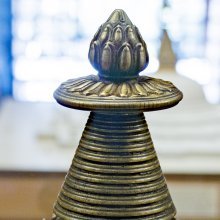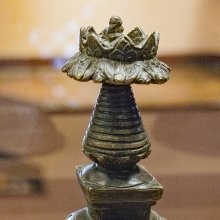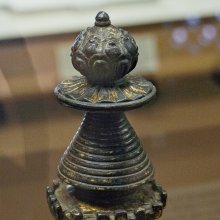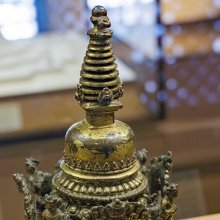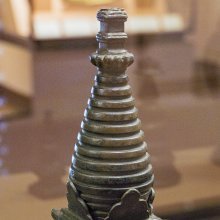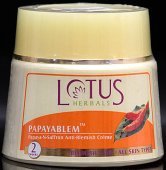Dot: 3 definitions
Introduction:
Dot means something in Hinduism, Sanskrit, biology. If you want to know the exact meaning, history, etymology or English translation of this term then check out the descriptions on this page. Add your comment or reference to a book if you want to contribute to this summary article.
Images (photo gallery)
(+2 more images available)
In Hinduism
Vastushastra (architecture)
Source: Shodhganga: Elements of Art and Architecture in the Trtiyakhanda of the Visnudharmottarapurana (vastu)Dots and (curved lines) represents an undesirable characteristic of those Stone that are to be used as a Material for the Construction of Temples, according to the Viṣṇudharmottarapurāṇa, an ancient Sanskrit text which (being encyclopedic in nature) deals with a variety of cultural topics such as arts, architecture, music, grammar and astronomy.—Finding of proper types of materials is one of the important aspects for any construction. Indian scriptures state that to procure the stones, the astrologer and the architect should go to mountain and examine the stones. The Viṣṇudharmottarapurāṇa specifies that some stones which are [e.g., filled with dots and curved lines, etc.] are to be totally abandoned. [...] So, it can be said that in the Viṣṇudharmottarapurāṇa, the collection of materials for the construction of temple does not suggest any process that harms others.

Vastushastra (वास्तुशास्त्र, vāstuśāstra) refers to the ancient Indian science (shastra) of architecture (vastu), dealing with topics such architecture, sculpture, town-building, fort building and various other constructions. Vastu also deals with the philosophy of the architectural relation with the cosmic universe.
Biology (plants and animals)
Source: Wisdom Library: Local Names of Plants and DrugsDot in the Oriya language is the name of a plant identified with Bruguiera cylindrica (L.) Blume from the Rhizophoraceae (Burma Mangrove) family having the following synonyms: Rhizophora cylindrica, Bruguiera caryophylloides. For the possible medicinal usage of dot, you can check this page for potential sources and references, although be aware that any some or none of the side-effects may not be mentioned here, wether they be harmful or beneficial to health.
Source: Google Books: CRC World Dictionary (Regional names)Dot in Vietnam is the name of a plant defined with Thysanolaena latifolia in various botanical sources. This page contains potential references in Ayurveda, modern medicine, and other folk traditions or local practices It has the synonym Vilfa scoparia (J. Presl) Steud. (among others).
Example references for further research on medicinal uses or toxicity (see latin names for full list):
· Systematisches Verzeichniss der von H. Zollinger in den Jahren 1842–1844 (1842)
· Bulletin de la Société Botanique de France (1919)
· Flora van Nederlandsch Indië (1857)
· Reliquiae Haenkeanae (1830)
· Gramineae (1841)
· Edinburgh New Philosophical Journal (1835)
If you are looking for specific details regarding Dot, for example health benefits, side effects, pregnancy safety, extract dosage, chemical composition, diet and recipes, have a look at these references.

This sections includes definitions from the five kingdoms of living things: Animals, Plants, Fungi, Protists and Monera. It will include both the official binomial nomenclature (scientific names usually in Latin) as well as regional spellings and variants.
See also (Relevant definitions)
Starts with (+64): Dot dang, Dota, Dotalu-mal, Dotara, Dotaragan, Dotarate, Dotdating, Dothara, Dotharatana, Dotharisu, Doti, Dotial, Dotigolu, Dotikolu, Dotivale, Dotiyikku, Doto, Dototo, Dotra, Dottadi.
Ends with: Dieng-soh-lyndot, Edot, Erdot.
Full-text (+150): Bindu, Anusvara, Viprush, Vindu, Shunya, Timba, Sanusvara, Bindurekha, Viplush, Hasakki, Bundaki, Pagada, Cibbu, Sibbu, Akkiyidu, Phutani, Reja, Combretum-with-the-white-dots, Silver-dot bushwillow, Silver-dot combretum.
Relevant text
Search found 71 books and stories containing Dot; (plurals include: Dots). You can also click to the full overview containing English textual excerpts. Below are direct links for the most relevant articles:
The Agni Purana (by N. Gangadharan)
Chapter 46 - Characteristics of different Śālagrāma stones
Chapter 148 - Mode of worship for success in the battle (saṅgrama-vijaya-pūjā)
Chapter 52 - Characteristics of images of different forms of goddesses
Garga Samhita (English) (by Danavir Goswami)
Verse 1.15.1 < [Chapter 15 - Revelation of the Universal Form to Nanda’s Wife]
Verse 1.15.30 < [Chapter 15 - Revelation of the Universal Form to Nanda’s Wife]
Verse 1.12.25 < [Chapter 12 - Description of Śrī Nanda’s Festival]
Guhyagarbha Tantra (with Commentary) (by Gyurme Dorje)
Text 4.15 (Commentary) < [Chapter 4 (text and commentary)]
Introduction 2: (The Essence, Classification and Purpose of Syllables) < [Chapter 4 (text and commentary)]
Text 4.9 (Commentary) < [Chapter 4 (text and commentary)]
The Padma Purana (by N.A. Deshpande)
Chapter 78 - Worship Prescribed for a Devotee of Viṣṇu < [Section 5 - Pātāla-Khaṇḍa (Section on the Nether World)]
Chapter 79 - Do’s and Don’t’s for a Devotee of Viṣṇu < [Section 5 - Pātāla-Khaṇḍa (Section on the Nether World)]
Chapter 81 - Mantracintāmaṇi for Devotees of Kṛṣṇa < [Section 5 - Pātāla-Khaṇḍa (Section on the Nether World)]
Kathasaritsagara (the Ocean of Story) (by Somadeva)
Note on Kali and Dvāpara and their connection with the dice < [Notes]
Note on nail-marks and tooth-bites < [Notes]
Note on the “letter of death” motif < [Notes]
Sripura (Archaeological Survey) (by Bikash Chandra Pradhan)
Chapter 5 - The Inventory of Coins
Sripura City Planning < [Chapter 2 - The Architectural Panorama]
Related products
(+2 more products available)

